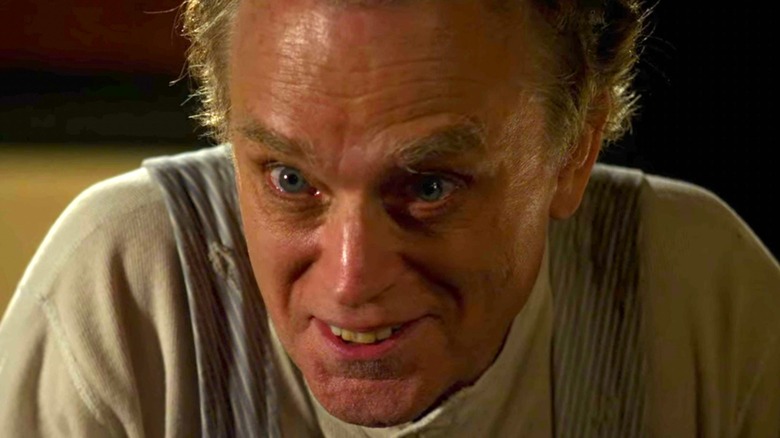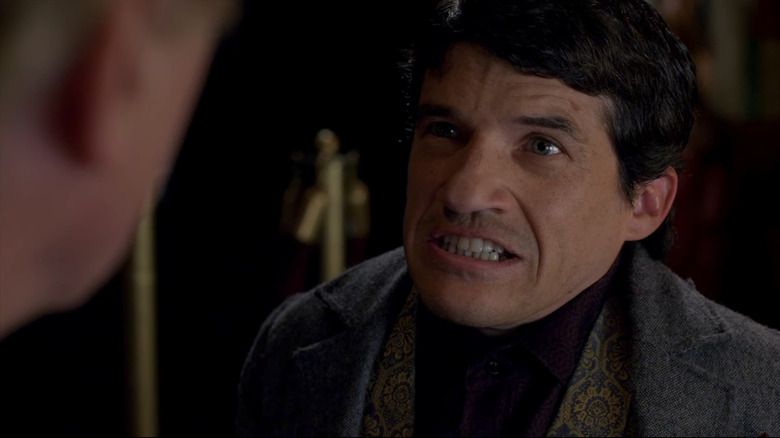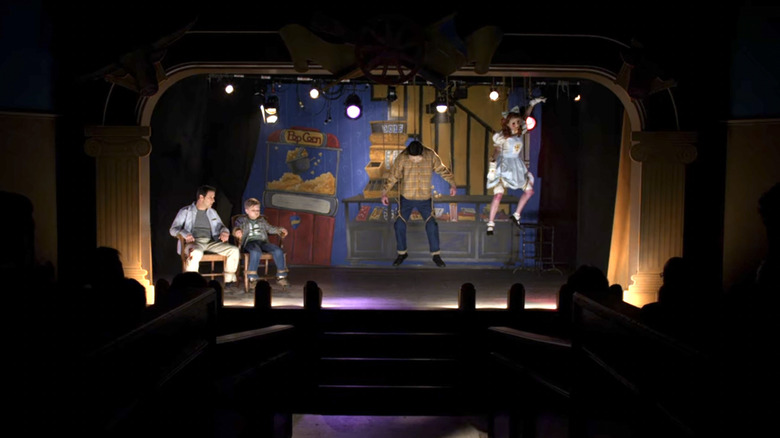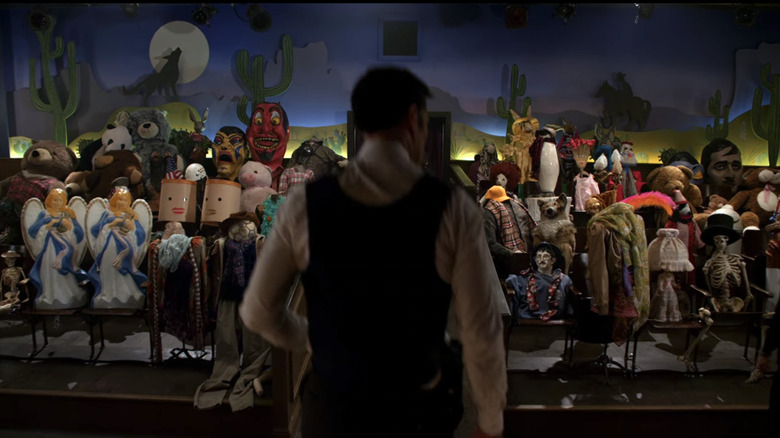Here's What Makes Criminal Minds Killer Adam Rain So Twisted
Over the course of its 15 seasons and 323 episodes, "Criminal Minds" has featured some seriously twisted unsubs — and some are even based on real murderers. Season 10's Mr. Scratch (Bodhi Elfman) used a combination of drugs and hypnosis to force people to kill their loved ones, while the serial killer and hitwoman Cat Adams (Aubrey Plaza), engaged in a duel of the minds with Dr. Spencer Reid (Matthew Gray Gubler) that lasted seasons — and cost hundreds of lives.
Although Mr. Scratch, Cat Adams, and other unsubs may have murdered more people than Adam Rain (played by Brad Dourif) from the Season 8 episode "The Lesson," it's the way that Adam kills that makes him so twisted. The Behavioral Analysis Unit (BAU) finds victims with their limbs popped out of their sockets, holes bored through their hands and feet, and freshly dyed black hair, costume makeup, and red-painted nails. Oh, and then they're placed in hand-crafted boxes and dropped off in public places. It's a tough case for the BAU, who can't quite get into Adam's murderous mind, but when they finally do, things are even more disturbing than anyone could have imagined.
Here's what makes Adam Rain so twisted.
The backstory of Adam Rain
The episode opens with Adam Rain startling awake from a year-long coma, then jumps ahead 3 months to present day, where Adam already has two victims — a couple — one dead and one still alive. More on them later. The biggest and often most interesting question about the unsubs of "Criminal Minds" is always "Why did they turn to a life of crime?" Tragically, Adam's answer lies not in some malice or sadism, but in his injured prefrontal cortex.
Adam had witnessed a traumatic event as a child, which would ultimately resurface — undealt with — when his mind reverted back to a childlike state after his coma. Adam's father, a puppeteer, was robbed at gunpoint before his eyes — and those of his father's marionettes, Mitch and Stephanie. When Adam's father refuses to give up his cash, the robber shoots and kills him, leaving Adam to wonder why the marionettes didn't step in to save the day. Now, as an adult who has lost his rational mind, Adam wants to recreate the scene on stage, with Mitch and Stephanie coming to his father's rescue and apprehending the robber, played by his assistant, Mr. Conrad (Mark Povinelli). But Mitch and Stef must be real people hung from the ceiling by wires, as the child Adam believed that marionettes were real people.
So, this plan to revise history and save his father in a play requires two human marionettes — light enough to be hung without breaking the contraption Adam made to manipulate them — as well as two captives to play his father and his childhood self. Now, back to the victims.
The crimes of Adam Rain
Adam abducted the couple, named Connie and Justin, together, so it's curious to the BAU that only Justin's body is found. Why would he keep Connie alive? But Justin's body is found in close succession with another man's, and both have had their hair dyed, makeup done, and nails polished. This leads the BAU to think that their unsub is trying to find a perfect fit for some fantasy, and although they mean "fantasy" in an addictive or even sexual way, they aren't too far off from the right explanation.
While lamenting Justin's improper fit for the role of Mitch, Adam and Mr. Conrad spot a small-statured man with black hair who seems perfect. They follow him home, then create a ruse to make him more vulnerable to abduction: Adam pretends to have been in an accident and approaches the man's door to ask if he can phone for help. Once inside, he sedates the man and takes him back to the stage where Connie has been suffering with her limbs dislocated from being hung from the ceiling. But the man dies from blood loss when Adam bores holes through his hands and feet, and must be discarded.
The BAU's investigation takes them to the thrift store where the clothes found on the two previous victims were bought, but the owner Tucker covers for Adam before rushing over to the stage to see if he's the one who harmed the men. Unfortunately for Tucker — another dark-haired man with a small build — his benefit-of-the-doubt attitude lands him right in the position to become the newest replacement for the role of Mitch. Finally, with the role secured and pressure mounting from Mr. Conrad, Adam sloppily abducts a father and son at gunpoint in the middle of a parking lot for the remaining roles.
A twisted play and a plot-twist ending
Surprisingly, the play sells out, with the small theatre packed with people. Things get off to a slow start. Adam gives a rambling introduction in which he talks about storytelling's ability to uncover truth and calls the play "a family tale of love and redemption." The curtains roll back, and immediately we see the father and son strapped to their chairs, with the father's leg dripping with blood from a gunshot wound. He calls out to the audience, "Somebody help us," but the crowd, although initially uneasy, assumes this is part of the play and continues to look on as the human marionettes — their faces now covered with papier-mâché masks — descend from above.
The play begins with abrupt lines delivered by unwilling actors, and Adam flashes back to the traumatic event, where he calls out to the marionettes, "Come on, do something! Do something! Please, Mitch, Steph!" before his father is shot to death. But before Adam's play can have Mitch and Steph "do something" to save his father, the BAU throws on the lights and stops the show. Chief Aaron "Hotch" Hotchner (Thomas Gibson) and Agent David Rossi (Joe Mantegna) convince him to break the cycle of violence and let them take the wounded victims to a hospital before they perish, and the crowd erupts in applause. Mr. Conrad is revealed to be a puppet himself (shocking!), and Adam is escorted down the center aisle, where he thanks viewers here and there. Does the audience still think this is all part of a play?
After Adam is gone, though, the truth is revealed: The audience was nothing but a bunch of props, animated in the mind of Adam, just as the marionettes had been when he was a child. As if the conclusion couldn't get any more chilling.



